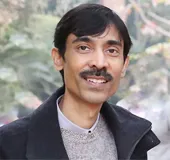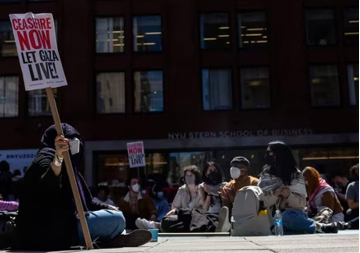Introduction
The population of the union territory of Delhi, pegged at 20 million in 2021,[1] is growing at a rate of 2.12 percent per annum,[2] making it ever more difficult for the responsible civic agencies to provide essential services to its inhabitants. Indeed, Delhi’s population is not only large in numbers but also highly diverse, compounding the difficulties. For example, an estimated 4 to 5 million people—or 25-30 percent of the city’s population—live in unauthorised colonies and slums.[3] Due to the unplanned nature of constructions and unauthorised residential status of the population, these communities are not being provided adequate basic services.
This brief examines the experience of the Delhi Jal (water) Board, the agency primarily tasked with the supply of water in the city—in obtaining raw water for meeting citizens’ needs. The focus on water is warranted due to several reasons: significant proportions of the population living in the city’s informal areas do not have access to piped water supply; in the planned areas, those who have piped supply receive water only for a few hours a day; and there are concerns about low water pressure and the inferior quality of water supplied through pipelines and water tankers. Worsening the situation is climate change and its manifold consequences on water resources. It is noted, for one, that rising temperatures and unpredictable rainfall patterns are intensifying both water scarcity and water-related hazards.[4] Data for the year 2023 shows a gap of 344 million gallons a day (mgd) between Delhi’s demand (1,290 mgd) and supply (946 mgd).[a],[5]
This brief attempts to build an understanding of how and from where the Delhi Jal Board collects raw water—which is then treated to make it safe for drinking—and the problems experienced in this task. Existing literature on this subject is scattered and offers a limited description of the issues involved. For example, there is hardly any official document in the public domain that accurately maps the course of raw surface water received in Delhi from various external sources. Similarly, there is a lack of information on the nature of inter-state water sharing disputes. These gaps in knowledge can impede the formulation of suitable strategies for raw water augmentation.
There are many factors responsible for the demand-and-supply gap in water, including water loss during treatment and distribution, wastage of treated water by consumers, water theft, non-functional water meters, and unmetered connections. This brief specifically conducts an appraisal of the issues pertaining to procurement of raw water from sources within and outside Delhi.
Sources of Raw Water
The Delhi Jal Board of the government of national capital territory of Delhi taps various external and internal water sources, such as water bodies on land surface (i.e. rivers, canals, ponds, and lakes), water below the ground (i.e. groundwater), water from rainfall, and sewage (i.e. waste water). These are illustrated in Figures 1 and 2 and described in the following paragraphs.
Fig. 1: Delhi’s Raw Water Sources
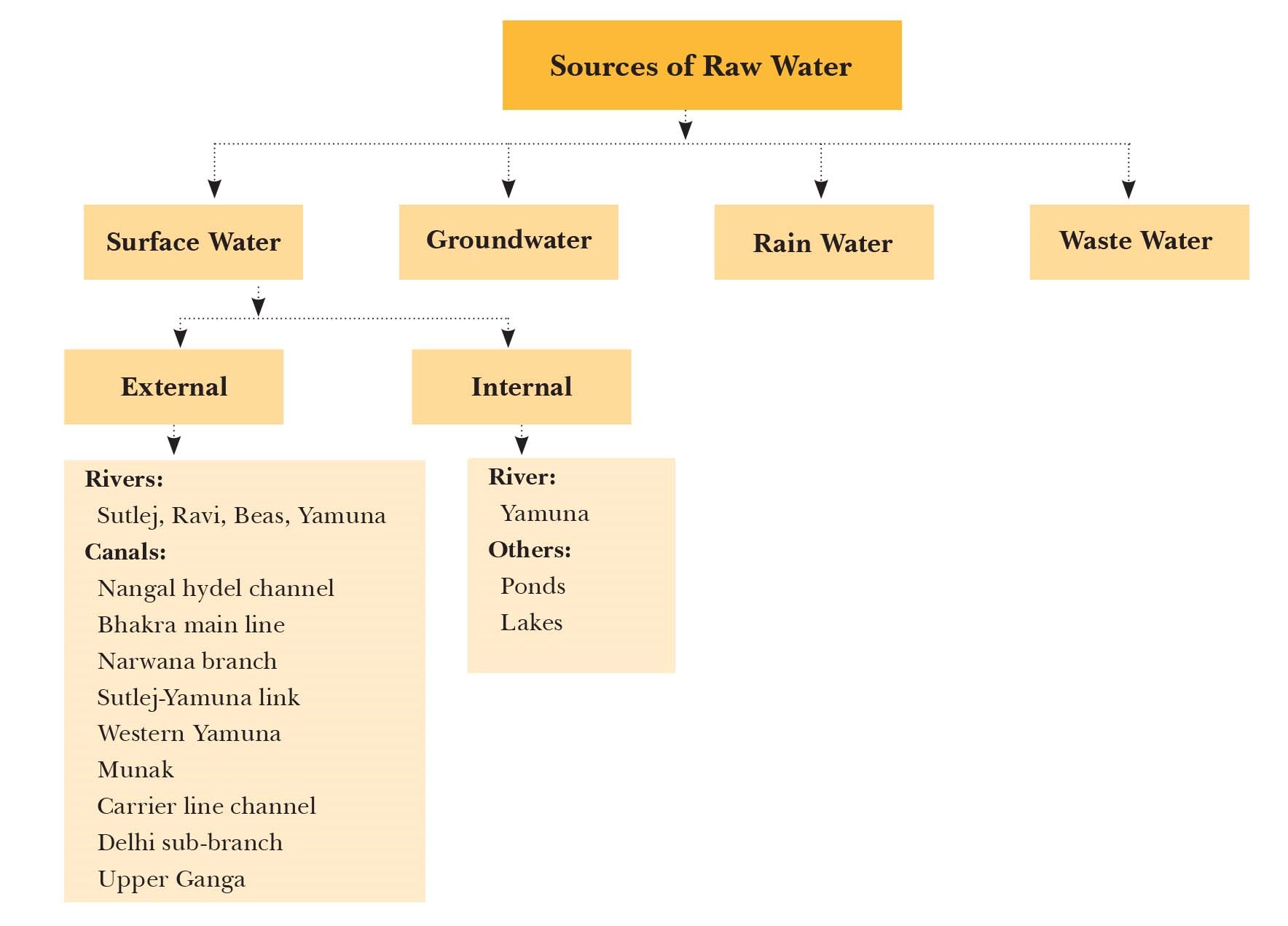
Source: Author’s own.
Surface Water
The biggest proportion of raw water is obtained from sources on land, or surface water. These include rivers and canals, which mainly lie outside Delhi, in the neighbouring states of Haryana, Uttar Pradesh, Punjab, Uttarakhand, and Himachal Pradesh.
Fig. 2: Rivers and Canals Serving Water to Delhi
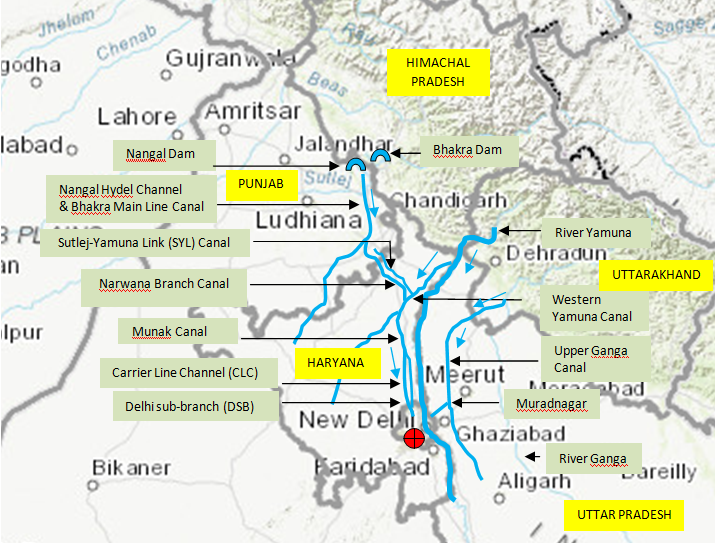
Source: Author’s own; base map from Esri India.[6]
The first source of raw surface water comprises four rivers (namely, Sutlej, Ravi, Beas, and Yamuna) from where water is transferred downstream to various locations through a network of canals. These canals are Nangal hydel channel, Bhakra main line canal, Narwana branch canal, Sutlej-Yamuna link (SYL) canal, western Yamuna canal (WYC), Munak canal, carrier line channel (CLC), and Delhi sub-branch (DSB). The supply and inter-state allocation of water from these sources is regulated by the Bhakra Beas Management Board (BBMB) and Upper Yamuna River Board (UYRB) that were constituted, respectively, in 1976 and 1995 to harness the potential of river water.
The Bhakra main line canal, an extension of the Nangal hydel channel that originates near the Bhakra and Nangal Dams built on river Sutlej, carries river water downstream to areas in Punjab, Chandigarh, Haryana, Delhi, and Rajasthan for irrigation and drinking purposes.[7] Towards eastern Punjab (near Sirhind town), the Narwana branch canal is connected to the Bhakra main line canal to carry water in a south-easterly direction towards Haryana.
Another inter-state canal, the Sutlej-Yamuna link (SYL), is partly constructed along the Bhakra main line and Narwana branch canals to connect Sutlej and Yamuna rivers. At present, the SYL canal is functional in Haryana (beginning from river Ghaggar near the Punjab-Haryana border), but its construction upstream in Punjab is being stalled by various issues related to inter-state coordination.[8]
At Karnal city (in northeast Haryana), the Narwana branch canal and SYL canal merge with the western Yamuna canal (WYC) that originates from river Yamuna at the Hathnikund barrage in north Haryana[b] and carries water in a southerly direction towards Delhi.
At Munak village (south-west of Karnal city), the Munak canal is connected to the WYC to divert some quantity of water to Delhi. The Delhi and Haryana governments signed a memorandum of understanding in 1996 for canal construction and water sharing. Munak canal has several branch canals, extensions, as well as parallel canals, including the carrier line channel (CLC) and Delhi sub-branch (DSB), that carry water from Haryana to Delhi. The CLC, for example, has been constructed from Munak (Haryana) to Haiderpur (Delhi) for transferring raw water.
Some quantity of raw surface water is obtained from the main river Yamuna that passes through Delhi. The river originates in the northern mountainous state of Uttarakhand and flows through Himachal Pradesh, Uttar Pradesh, Haryana, and Delhi. The total length travelled by the river is about 1,376 km; within the territory of Delhi, the river flows a distance of about 52 km.[9]
The second source of raw surface water is the upper Ganga canal. This canal originates from river Ganga near Haridwar (Uttarakhand) and carries water southwards to Uttar Pradesh. Near Muradnagar (Uttar Pradesh), situated towards northeast of Delhi, a pipeline is laid to transfer some quantities of canal water to Delhi.[10]
Third, several natural and government-created water bodies, i.e. ponds and lakes, within Delhi are being utilised to recharge groundwater. Some of these are lying in a neglected state. Since these have high storage capacity for accommodating monsoon flows and have numerous environmental benefits, the Delhi Jal Board has undertaken a project for cleaning and maintenance of existing as well as neglected water bodies. Further, new ones are being created on available vacant land that will help in the recharge of groundwater.
Groundwater
After surface water (received from various external and internal sources described above), groundwater is the second most significant source of raw water for Delhi. This water is obtained through some 5,169 tube wells functional across various areas of Delhi, as well as 11 ranney wells[c] constructed in the Yamuna flood plains.[11]
Rain Water
The Delhi government has been pursuing a policy of harvesting rain water since 2012, primarily for replenishment of groundwater.[12] In 2016, it made it mandatory to install rain water harvesting (RWH) structures in all public and private plots and properties measuring 100 sq m and above, as well as in all government buildings.[13] The Delhi Jal Board itself, for example, has constructed RWH structures in 594 of its buildings. The structures are also installed in 4,144 schools and colleges of Delhi, and in certain housing colonies, health and educational institutions, parks, metro rail properties, and the Indira Gandhi international airport.[14] Early evidence suggests that rain water harvesting helps stabilise groundwater levels. To encourage the uptake of this method, the Delhi government accepts applications for grants for setting up RWH structures.
Waste Water
A significant proportion of treated water pumped into pipelines goes into sewer lines after consumption. Some of this waste water is treated in sewage treatment plants (STPs) for reuse in non-potable activities, such as irrigation, horticulture, construction, and power generation. The use of treated waste water has marginally reduced the pressure on surface and groundwater sources.[15]
Challenges to Obtaining Adequate Raw Water
At present, the quantity of raw water available in Delhi from various sources is about 984 million gallons per day (mgd). As the data provided in Table 1 shows, up to 88 percent of raw water is obtained from various external and internal surface sources, which include CLC, DSB, river Yamuna, and upper Ganga canal. The remaining 12 percent is extracted from the ground within the territory of Delhi. Thus, surface water bodies are the most important sources of raw water for Delhi, and the city largely relies on neighbouring states for meeting its raw water needs. Further, it is noted that the city generates about 792 mgd of sewage, of which about 70 percent (or 550 mgd) is treated for use in non-potable activities.
Table 1: Raw Water Available in Delhi, Per Day
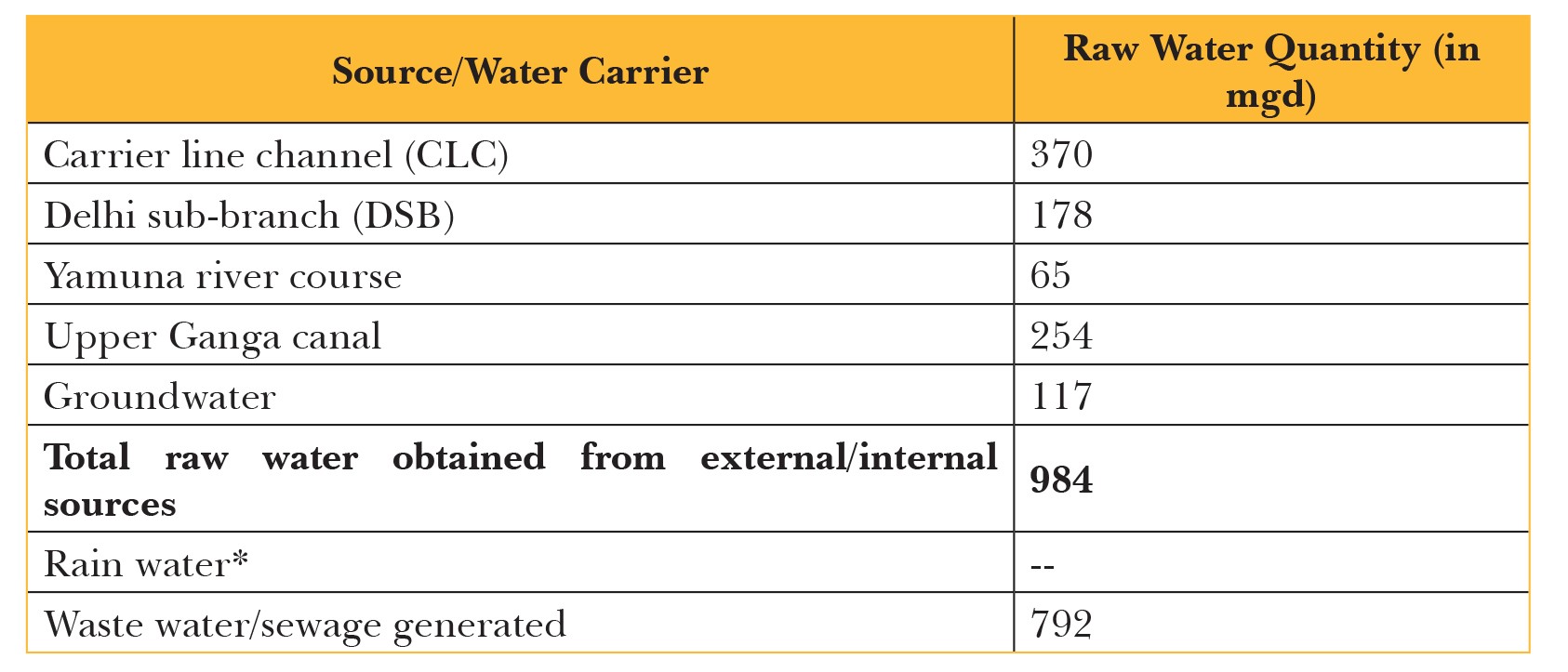
Source: Government of NCT of Delhi, Economic Survey of Delhi 2023-24 (Delhi: Planning Department).
Note: * Data on total quantity of rain water harvested in Delhi is not available.
These volumes are found to be inadequate compared to the needs of the territory. There are multiple factors constraining the Delhi Jal Board’s performance, and they are discussed in the following paragraphs.
a. Inter-state disputes: Delhi’s external sources of water are in the neighbouring states of Himachal Pradesh, Uttarakhand, Punjab, Haryana, and Uttar Pradesh. The challenge is nurturing cooperation between these states, which are governed by different political parties, in water sharing.
For example, the Punjab government is opposed to sharing the state’s canal water with Haryana, and has stalled the construction of the Sutlej-Yamuna link (SYL) canal which was agreed in 1981 and began in 1982.[16] According to the Punjab government, the state’s groundwater levels are declining and thus it has no surplus water to share.[17] Therefore, the full potential of the SYL canal remains untapped, affecting the flow of raw water to Delhi. In 2002, the Supreme Court intervened and ordered Punjab to cooperate with the Union government and Haryana and complete the canal construction work. The lack of resolution to this conflict in the past several years has affected the livelihoods of many farmers in Punjab, whose lands were acquired for the construction of the canal. The lands were subsequently returned to the farmers, but they were left barren and unsuitable for cultivation after they had been used for canal construction-related works.
Similarly, the Delhi government has criticised the Haryana government for releasing less water in Munak canal than what was agreed upon. In response, Haryana has maintained that the water it is releasing is as per the inter-state water sharing agreement, and that the reason Delhi is experiencing water scarcity is internal mismanagement.[18] Haryana also accuses Delhi of failing to pay its share of carrier line channel (CLC) construction, and not contributing its share of the costs of canal upkeep.[19]
Adding to the challenge is the occasional public protests that cause the various canals to be blocked, exacerbating the water crisis in Delhi. In 2010, for example, the upper Ganga canal water was blocked at Muradnagar in Uttar Pradesh, as a community was demanding reservation in higher education and government jobs.[20] A similar problem was experienced in 2016 when a group of protesters closed the gates of Munak canal in Haryana.[21]
b. Delays in project implementation: To augment raw water availability, the Delhi government is pursuing early construction of three upstream storages on river Yamuna and its tributaries in two northern states: Renuka dam in Himachal Pradesh, Kishau dam at the border of Uttarakhand and Himachal Pradesh, and Lakhwar-Vyasi dam in Uttarakhand. At present, progress is stalled due to disagreement among participating states on issues of funding, including bearing of power component cost.
c. Infrastructure deficiencies: The condition of water carriers and channels is affected by seasonal and technical problems. For example, breaches are commonly experienced in downstream canals, which result in water loss, inundation of neighbouring areas and damage to property, and soil degradation. Multiple reasons are responsible for their occurrence, including excessive rainfall and landslides in upstream areas that create pressure on the canal’s carrying capacity downstream. In October 2023, a 150-feet-long breach in the boundary wall of CLC occurred about 20 km upstream of the Delhi-Haryana border.[22] Two more problems temporarily affecting the flow of raw water to Delhi are the annual practice of upper Ganga canal cleaning, for which temporary closure is required; as well as water loss during conveyance: about 5-percent loss in CLC and 30-percent loss in old DSB canal.[23]
d. Neglected surface water bodies: A report on the condition of 893 ponds and lakes across Delhi released by the Ministry of Jal Shakti in early 2023 found that 26.5 percent were in use for groundwater recharge, some of which have been encroached upon, whereas 73.5 percent were not in use due to either drying up or the presence of sewage, solid waste, and industrial effluents.[24] The absence of sewer lines in some low-income areas, especially those located along the national rail corridors and open drains, causes flow of sewage to water bodies.
e. Poor raw water quality: The water in the Delhi stretch of river Yamuna contains pollutants, such as ammonia,[d] that are often untreatable through chlorination. In April 2023, for example, ammonia levels were recorded at 8.1 parts per million (ppm), which is far more than the one ppm required limit for treatment.[25] A similar rise in ammonia levels was recorded in December 2023. The Delhi Jal Board claims that untreated drain water and pollutants flow into the river at various locations upstream. In such situations, it becomes impossible to obtain adequate raw water and meet the drinking water needs of consumers in west, north, and south Delhi.[26] The DJB plans to construct an ammonia treatment plant for this purpose.
The Yamuna river bed also contains weeds, silt, sand, sediments, and debris, which affect water flow, water holding capacity, and quality of water.[27] This problem is being addressed through a dredging and desilting exercise. In the case of upper Ganga canal, the growth of algae in the water was recorded in April 2023, which affected water production and supply in Delhi.[28]
The quality of canal water is also affected by the presence of human and bovine carcasses. In April 2017, twelve human carcasses were recovered during a cleaning of Narwana branch canal in Jind district of Haryana.[29] Human and animal carcasses have also been found in the SYL canal.[30]
f. Groundwater decline and contamination: Two concerns noted with regard to groundwater are its decline by about 20-30 metres in some areas of Delhi, and the presence of pollutants.[31] Some reasons responsible for such decline are its unauthorised extraction by vested groups (such as owners of farm houses and private water suppliers) through tube wells, inadequate recharging of groundwater due to few arrangements for rain water harvesting, as well as construction of unauthorised structures that obstruct the natural flow of rain water to low-lying natural areas and water bodies. Regarding groundwater quality, toxic metals (e.g., fluoride, nitrate, and arsenic) beyond prescribed limits have been found in some areas, and there is evidence of increasing salinity. According to the Central Ground Water Board (CGWB), groundwater can be an important source of water for Delhi if its level is maintained, and is measured, managed and protected properly. CGWB estimates point to an annual groundwater recharge (or replenishment)[e] of 38,152.55 hectare meters (ham), and net groundwater availability of 2,870 ham for future use in Delhi.[32]
g. Slow progress in rain water harvesting and waste water treatment: The DJB has undertaken steps to ensure availability of more water from internal sources but is meeting with a number of obstacles. For example, the installation of RWH structures is yet to become a universal practice among those required to do so; of those structures that have been installed, many are not being maintained properly, with filters and bore pipes clogged by soil in recharge pits. Further, storm water drainage infrastructure deficiencies exist, which often result in flooding in various parts of the city during the monsoon season.[33] The expansion of sewer networks to informal areas is also required, along with improvements in the flow of entire sewage generated to sewage treatment plants, and sewage treatment and utilisation.
Conclusion
A study of methods followed by Delhi’s water agency in obtaining raw water shows that various sources are being tapped, such as surface water, groundwater, rain water, and waste water. The assessment further reveals that the civic agency is not able to obtain desired quantity and quality of raw water due to a number of issues pertaining to its own performance in managing water resources and infrastructure within Delhi, as well as the implementation of projects. There are also challenges in the extent of cooperation received from neighbouring state governments.
In the given circumstances, it will be useful for Delhi’s water agency to augment the raw water base from internal sources. This requires collecting more quantities of rain water and waste water, greater recharge of groundwater, and keeping surface water bodies clean. The urban plan monitoring and enforcement agency should also control the problem of unauthorised constructions at various places in the city that prevent water percolation into the ground.
Rumi Aijaz is Senior Fellow at ORF.
Endnotes
[a] The figure for demand is based on the norm of 60 gallons per capita per day (gpcd).
[b] The Hathnikund barrage diverts limited quantities of river Yamuna water into eastern and western Yamuna canals. The eastern Yamuna canal carries water to Uttar Pradesh, while the western Yamuna canal carries water to Haryana and Delhi. The remaining water stays in the main river that flows through Uttar Pradesh, Haryana, and Delhi.
[c] A ranney well, named after Texas petroleum engineer Leo Ranney, is a well constructed to extract raw water from water-bearing rocks (or aquifer).
[d] A colourless, poisonous gas with noxious odour mainly produced by decay of plant and animal matter, untreated industrial chemicals and sewage.
[e] Recharged from rainfall, canal/drain/domestic water supply seepage, return flow from irrigation, and from water conservation structures.
[1] Government of NCT of Delhi, Economic Survey of Delhi 2023-24, Demographic Profile, Chapter 19 (Delhi: Planning Department), 453, https://delhiplanning.delhi.gov.in/sites/default/files/Planning/chapter_19_0.pdf.
[2] Government of NCT of Delhi, Economic Survey of Delhi 2023-24, Demographic Profile, Chapter 19, 441.
[3] Upasika Singhal, “Only 4 lakh registrations: Why Delhi’s unauthorised colonies lag behind,” The Indian Express, December 20, 2023, https://indianexpress.com/article/cities/delhi/only-4-lakh-registrations-why-delhis-unauthorised-colonies-lag-behind-9075310/.
[4] United Nations, “Water – at the center of the climate crisis,” https://www.un.org/en/climatechange/science/climate-issues/water.
[5] Government of NCT of Delhi, Economic Survey of Delhi 2023--24, Water Supply and Sewerage, Chapter 13 (Delhi: Planning Department), https://delhiplanning.delhi.gov.in/sites/default/files/Planning/chapter_13.pdf.
[6] Esri India Technologies Private Limited, “Policy Maps,” https://policymaps.esri.in/maps/17e8e809b4f64313b4b8e6883015c969/explore?location=31.255376%2C77.650268%2C6.00.
[7] Government of Punjab, “Canal Administration,” Department of Irrigation, https://irrigationapp.punjab.gov.in/OldVersion/canal_administration_cansystem.html.
[8] Ministry of Jal Shakti, “Sutlej-Yamuna Link Canal,” Department of Water Resources, River Development and Ganga Rejuvenation, January 9, 2023, https://jalshakti-dowr.gov.in/sutlej-yamuna-link-canal/.
[9] Delhi Development Authority, “Journey of River Yamuna,” Landscape and Environmental Planning Department, https://dda.gov.in/land-/Journey-Of-Yamuna.
[10] Ministry of Jal Shakti, “Chief Engineer-II (Ganga), Meerut,” Irrigation and Water Resources Department, Government of Uttar Pradesh, https://www.idup.gov.in/en/page/chief-engineer-ii-(ganga),-meerut.
[11] Government of NCT of Delhi, Economic Survey of Delhi 2023-24, Water Supply and Sewerage, Chapter 13.
[12] Delhi Jal Board, Delhi Water & Sewer (Tariff and Metering) Regulations, 2012 (Delhi: DJB, 2012), 23-24, https://delhijalboard.delhi.gov.in/sites/default/files/Jalboard/generic_multiple_files/dw_s_tariff_metering_reg_2012.pdf.
[13] Delhi Jal Board, Rain Water Harvesting Guidelines (Delhi: DJB, 2016), https://delhijalboard.delhi.gov.in/sites/default/files/Jalboard/generic_multiple_files/rwh_guidline_13072016.pdf.
[14] Government of NCT of Delhi, Economic Survey of Delhi 2022-23 (Delhi: Planning Department).
[15] Government of NCT of Delhi, Economic Survey of Delhi 2023-24, Water Supply and Sewerage, Chapter 13, 272.
[16] Sanjeev Verma, “A picture of contrast: Water table sinking, but farmers just watch Bhakra canal overflow,” The Times of India, October 17, 2023, https://timesofindia.indiatimes.com/city/chandigarh/a-picture-of-contrast-water-table-sinking-but-farmers-just-watch-bhakra-canal-flow/articleshow/104506850.cms.
[17] Vikas Vasudeva, “Emotive issue of Sutlej-Yamuna link canal takes political centre stage again in Punjab, Haryana,” The Hindu, October 6, 2023, https://www.thehindu.com/news/national/other-states/emotive-issue-of-sutlej-yamuna-link-canal-takes-political-centre-stage-again-in-punjab-haryana/article67384648.ece.
[18] “Delhi HC tells Haryana to stick to 2014 water agreement,” The Times of India, March 14, 2018, https://timesofindia.indiatimes.com/city/delhi/hc-tells-haryana-to-stick-to-2014-water-agreement/articleshow/63291469.cms.
[19] Paras Singh, “Delhi’s water supply likely to be hit after canal breach near Sonepat,” Hindustan Times, June 15, 2023, https://www.hindustantimes.com/cities/delhi-news/water-crisis-in-new-delhi-munak-canal-breach-causes-low-pressure-for-3-million-people-repairs-to-take-48-72-hours-101686767282590.html.
[20] “Protesters block water supply to Delhi,” India Today, June 14, 2010, https://www.indiatoday.in/india/north/story/protesters-block-water-supply-to-delhi-76532-2010-06-13.
[21] Juhi Chaudhary, “Jat protests dry up Delhi,” The Third Pole, February 23, 2016, https://www.thethirdpole.net/en/pollution/jat-protests-dry-up-delhi/.
[22] Paras Singh, “Repair work at Haryana water canal on, normalcy by Tuesday: Delhi Jal Board,” Hindustan Times, October 9, 2023, https://www.hindustantimes.com/cities/delhi-news/repair-work-at-haryana-water-canal-on-normalcy-by-tuesday-delhi-jal-board-101696788026181.html.
[23] Government of NCT of Delhi, Economic Survey of Delhi 2023-24, Water Supply and Sewerage, Chapter 13.
[24] “What’s happening to Delhi’s water bodies? 216 encroached upon, 77 not in use: Census data shows,” The Indian Express, April 25, 2023, https://indianexpress.com/article/cities/delhi/quarter-of-water-bodies-in-city-are-encroached-census-shows-8574028/.
[25] Siddhanta Mishra, “Ammonia in Yamuna water high, water treatment at 2 plants down 25%,” The Times of India, December 26, 2023, https://timesofindia.indiatimes.com/city/delhi/ammonia-in-yamuna-high-water-treatment-affected-delhi-jal-board/articleshow/106277887.cms.
[26] Paras Singh, “Delhi Jal Board: Raw water released to flush Yamuna pollution,” Hindustan Times, April 5, 2023, https://www.hindustantimes.com/cities/delhi-news/delhi-jal-board-takes-steps-to-restore-water-treatment-plants-as-ammonia-levels-rise-in-yamuna-river-affecting-supply-to-north-and-west-delhi-101680634919193.html.
[27] “Delhi Jal Board to begin dredging, desilting in Yamuna riverbed,” Hindustan Times, August 9, 2023, https://www.hindustantimes.com/cities/delhi-news/delhi-jal-board-to-start-dredging-and-desilting-of-yamuna-riverbed-to-improve-water-holding-capacity-and-quality-101691605394544.html.
[28] Delhi Jal Board, X post, April 10, 2023, https://twitter.com/DelhiJalBoard/status/1645400818345218048.
[29] Satender Chauhan, “Haryana: 12 bodies recovered from Bhakra Nangal canal in Narwana,” India Today, April 2, 2017, https://www.indiatoday.in/india/story/12-bodies-recovered-from-bhakra-nangal-canal-in-haryana-969057-2017-04-02.
[30] “Haryana farmers too want SYL land returned,” The Times of India, March 13, 2016, https://timesofindia.indiatimes.com/city/chandigarh/haryana-farmers-too-want-syl-land-returned/articleshow/51377131.cms.
[31] Government of NCT of Delhi, Economic Survey of Delhi 2023-24, Water Supply and Sewerage, Chapter 13.
[32] Central Ground Water Board, Dynamic Ground Water Resources of NCT, Delhi (Delhi: State Unit Office, October 2023), https://www.cgwb.gov.in/cgwbpnm/public/uploads/documents/1708414374816562110file.pdf.
[33] Delhi Development Authority, Draft Master Plan for Delhi – 2041 (New Delhi: DDA Master Plan Section, 2021).
The views expressed above belong to the author(s). ORF research and analyses now available on Telegram! Click here to access our curated content — blogs, longforms and interviews.

 PDF Download
PDF Download

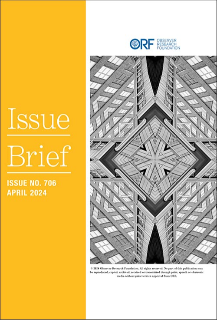




 PREV
PREV
